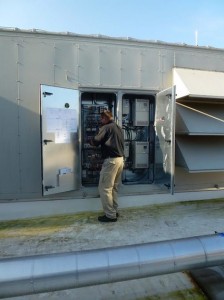
Replacing an old commercial HVAC system is one of the most important duties a property manager has.
Your existing commercial HVAC system might break down in the scorching heat of summer. If regular maintenance isn’t enough to salvage it, perhaps it is time to consider installing a brand new system. Replacing an old commercial HVAC system is one of the most important duties a property manager has. Here is a guide to expedite the process.
Consider Outcomes of Commercial HVAC System Installation
One of the most important aspects of the installation process is considering the outcomes. How comfortable will you and your employees be once the new commercial HVAC system is up and running? Remember, the more comfortable a building is, the more productive its inhabitants can be. Also, consider the overall scope of the system replacement. When determining how extensive the system replacement will be, calling on expert help from specialists is the best course of action. These specialists will help you and your employees decide how to arrange the proper configuration for your new commercial HVAC system.
Ensure Load Distribution is Properly Accounted For
Before beginning renovations on your system, consider where it is located in your building. The renovations may call for a change in the existing floor plan, which means you may need a system that is either larger or smaller than its predecessor. Upgrades that take advantage of more up to date technology, such as Variable Frequency Drives (VFD) and Variable Refrigerant Flow (VRF), present more possibilities for improving your current system. What can these technologies do? Variable Frequency Drives allow the drive motors on commercial HVAC systems to run at a lower operating speed. With Variable Refrigerant Flow, HVAC systems can be made more energy-efficient. They also operate more smoothly, making less noise while they distribute heated or cooled air more evenly throughout your building.
If your current commercial HVAC system has been around long enough, it is likely to be too massive for its location. Older commercial HVAC systems are commonly built to be too large. Systems that are too large will have to work harder, because these systems will switch on and off. This constant switching on and off is known as short cycling, which can lead to higher energy usage and uncomfortable conditions throughout your building. Besides factoring in system size and available floor space, other design choices to consider include upgrading doors and windows and changing the insulation and lighting in the room. With the proper configuration, load distribution can be achieved more efficiently. Improved load distribution allows the entire system to run more efficiently while consuming far less energy.
Ventilation Is Important
When a commercial HVAC system is operating at peak efficiency, hot and cold air is spread throughout the building wherever and whenever it is needed. But HVAC systems are more versatile than just providing heating and cooling. Ventilation, especially proper ventilation, is another important function performed by the optimized commercial HVAC system. Not only will stale air be replaced by fresh air, but other environmental factors affecting indoor air quality will be addressed – for instance, the humidity will be regulated, while foul odors and dust clouds will be minimized or circulated out altogether. In addition, other hazards such as carbon dioxide and germs will be dispatched as well.
Prevent Energy Waste
Saving energy and preventing energy waste is another major concern when evaluating your commercial HVAC system for possible replacement. Maximizing energy efficiency can help lower the bills and save you money. While the local weather should be included as a factor in determining the optimal levels of energy usage inside your building, another clever solution for energy waste is setting different heating and cooling levels for different areas of your building. Conference rooms and other similar rooms are often left unoccupied for most of the work day. Thus, consider having different temperatures set for these areas as opposed to other areas that see much more employee traffic. One way to achieve this setting is to install multiple thermostats.
Crockett Facilities Can Help!
Crockett Facilities Services, Inc. (CFSI) is committed to helping building owners, property managers, engineers, and facility professionals lower their operating expenses through HVAC preventive maintenance. We can develop a cost-effective, customized preventive maintenance plan for your commercial building that will provide you with peace of mind, improved comfort, and energy savings.
To learn more about the importance of HVAC Preventive Maintenance, please contact us at 202.600.2787 or sales@crockett-facilities.com. Our PM contract customers receive priority service with 24/7 emergency service in Maryland, Virginia and Washington, DC.
